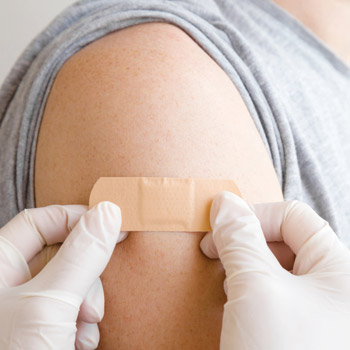Getting to the new normal
A new way of conducting office visits in the wake of the COVID-19 pandemic seems frightening at first, but the precautions taken instill in patients confidence that they are safe visiting their doctor.
As I write, Easter has just passed, with the azaleas and dogwoods in full bloom here in Georgia. They belie the invisible virus that has been galloping throughout our communities for the previous six weeks. Paradoxically, the beautiful spring and the COVID-19 pandemic are concurrent. But that is life, isn't it? Babies continue to be born, while other lives are lost to many causes of death, including COVID-19. The silver lining of any crisis is always the opportunities and the blessings that can only come through suffering. As Marcel Proust said, “Illness is the doctor to whom we pay the most heed; to kindness, to knowledge, we make promises only; pain we obey.”
The pain and suffering brought on by the COVID-19 pandemic force us all to stop, to change what we are doing, to do things differently, to try new things, to evolve our lives and our health care practices. This pandemic represents a seminal event in our generation and our lives as physicians. The many weaknesses in our health care system are laid bare. Physician practice innovation, languishing for more than a decade, has occurred overnight with the vital need to care for patients at a distance and not in our offices. It's amazing how quickly things can happen when you simplify regulations and pay a fair price! We are rapidly moving to a “new normal” in our daily lives both at home and at work.
At my office, we have a new normal of patient workflow with a combination of very limited in-person office visits, mostly now telehealth visits, and an acute respiratory illness clinic in a tent behind our office every afternoon. In our current new workflow, our patients are greeted outside the front door of the office by medical assistants in full personal protective equipment (PPE) who stand as sentries to protect all those inside. Instead of the initial warm greeting by our kind and compassionate receptionist, they now experience what seems like an interrogation and temperature checks before they are allowed entry. Surprisingly, our patients welcome this, as it seems to instill confidence that they are safe here.
Our lobby is half-empty of chairs and people. The few patients we see in person are quickly whisked from the lobby to treatment rooms with little time to read a magazine, listen to the medical education television, or greet friends and acquaintances. All of our staff and physicians remain disguised in our masks throughout the day, if not at our desks shut up in our personal offices on telemedicine visits. Scrubs, surgical gowns, gloves, and masks are the new wardrobe in my primary care office. The smell of disinfectant solutions and sprays permeates the air. We go through hand sanitizer, soap, and paper towels like never before. The COVID-19 pandemic has thrust us into a historic, strange, and surreal new world.
Every day still continues to bring new COVID-19 cases and deaths in our country, although we are clearly seeing flattening of the curve of new cases in many places. However, due to continued limited testing, how do we really know? The new questions now are how long must we continue restrictive social distancing measures in our locales, and to what degree? How do we methodically and reasonably resume economic and social activities in a safe, phased-in approach without seeing a frightening resurgence of the virus in the ensuing weeks? Public officials balancing the risk of resurgence with the economic desperation of so many to get back to work have a difficult job indeed.
The COVID-19 pandemic exposed enormous voids in our present health care system, most of which we already knew. A good economy made us complacent. The infectious pandemic and the economic catastrophe it wrought underscore our broken U.S. health care system. Our present system costs too much, leaves too many behind, and has woefully underinvested in primary care and in the public health infrastructure. We were not prepared for the pandemic the infectious disease and public health professionals knew would come someday. We had two shots across the bow within the past two decades with SARS-CoV-1 in 2002-2004 and the MERS virus in 2012. These outbreaks had limited impact on the U.S., so we were not worried.
We have been complacent for years with a broken health care system that has only gotten worse. As long as half the country had employer-sponsored health care that most were “reasonably satisfied” with, we were smug and let it continue. The catastrophic job losses since March have now created many more uninsured people. It is the double insult of unemployment and subsequent loss of health insurance that has made us all vulnerable. We must unlink our employer from our personal health insurance for many reasons, including job loss, or job changing, or starting your own business, or changing to part-time work, or coverage for birth control, just to name a few.
ACP published “Better Is Possible: ACP's Vision for the U.S. Health Care System” in January, which prophetically laid out pathways with critical components to get us to a better health care system as a new normal in the U.S. We envisioned a system where everyone has coverage for and access to the care they need, at a cost they and the country can afford, where unnecessary burdensome administrative barriers to care are removed, where robust investment in primary care and public health is made, and where payments and charges are transparent and predictable. Our vision is one where payment systems truly value the expertise and skills of internal medicine specialists.
Our country would have been much better prepared for COVID-19 if our vision was already in place. The question now is how do we successfully navigate this pandemic over the next two years with the present broken system, and will we make the desperately needed changes to be better prepared for the next pandemic?
Throughout the COVID-19 crisis, ACP is working tirelessly, mostly from home, to provide daily updated information on its COVID-19 hub. This Herculean task created and accomplished by our ACP Medical Education staff in Philadelphia is a phenomenal resource with open access to the world. Just as amazing is the outstanding advocacy work done by our Governmental Affairs staff in Washington, D.C. The D.C. office is advocating through multiple channels and with numerous groups, including congressional leaders, the National Governors Association, HHS, CMS, and America's Health Insurance Plans (AHIP), for:
- physician practice support,
- advanced Medicare payment,
- per member per month payments,
- telemedicine and telephone visit payment parity with evaluation and management codes,
- access to PPE,
- rapid provision and access to COVID-19 testing, and
- guidelines to safely phase in economic and social activities.
They have also developed a COVID-19 toolkit to help Chapters advocate at the state level. ACP is truly helping members to navigate the challenging path ahead toward the new normal in health care.
So, what will be remembered about this pandemic? Certainly, the social distancing, the economic disaster, the shortages of PPE and ventilators, the tragic loss of life. But we will also look back on how necessity birthed new uses of technology and supply chains, an increased social awareness of one another and our local communities, and an understanding of the critical importance of fully funding public health departments, CDC, and the WHO, with the realization that we are truly all in this together throughout the world.
Let it also be remembered that this crisis has been one of medicine's finest hours. Two of the heroes are Anthony Fauci, MD, MACP, and Deborah L. Birx, MD, who stand shoulder to shoulder with us, their fellow internal medicine physicians and other physician colleagues who are called daily to go into harm's way to render aid to our patients in hospitals, long-term care facilities, clinics, and homes.
Let the next generation look back and remember the leadership physicians provided, the care that was administered, and the difference that medicine (especially internal medicine) made in the health of our world. As physicians, we have a calling that transcends politics, socioeconomics, and disease, that promotes health and healing for the individual patient and the general public. In the Hippocratic tradition, today's physicians continue to answer to medicine's high ethical calling. We advance the legacy of generations of physicians before us by continuing to combine the principles of science with the art of healing. As physicians, embracing scientific principles and compassionately applying these healing truths not only defines us but challenges us today and is what we will be remembered by in the future.
Our forced evolution into a new normal is not what we wanted, but it is our present reality. Life and death go on with COVID-19 in the background, upsetting our plans and forcing us into new frontiers we never imagined. Let this pain and suffering of the COVID-19 pandemic, and the trillions of federal and state dollars spent on bailout from poor planning, not be wasted. Let it be the expensive tuition for lessons learned getting to the new normal.




